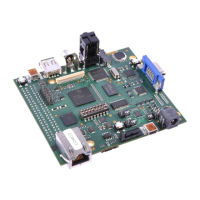TMS
320
C6748
( )
ZWT
( ) ( )
PREFIX
TMX = Experimental Device
TMS = Qualified Device
DEVICE FAMILY
320 = TMS320™ DSP Family
DEVICE
C6748
DEVICE SPEED RANGE
3 = 300 MHz (Revision 1.x)
TEMPERATURE RANGE (JUNCTION)
Blank = 0°C to 90°C, Commercial Grade
PACKAGE TYPE
(A)
361-Pin Plastic BGA, with Pb-free Soldered
Balls [Green], 0.65-mm Ball Pitch
ZCE =
SILICON REVISION
Blank = Revision 1.0
ZWT = 361-Pin Plastic BGA, with Pb-free Soldered
Balls [Green], 0.8-mm Ball Pitch
A = Revision 1.1
B = Revision 2.0
E = Revision 2.3
4 = 456 MHz (Revision 2.x)
3 = 375 MHz (Revision 2.x)
A = –40°C to 105°C, Extended Grade
D = –40°C to 90°C, Industrial Grade
(B)
E
Basic Secure Boot Enabled
264
TMS320C6748
SPRS590G –JUNE 2009–REVISED JANUARY 2017
www.ti.com
Submit Documentation Feedback
Product Folder Links: TMS320C6748
Device and Documentation Support Copyright © 2009–2017, Texas Instruments Incorporated
A. BGA = Ball Grid Array
B. Parts marked revision B are silicon revision 2.1 if '21' is marked on the package, and silicon revision 2.0 if there is no
'21' marking.
Figure 7-1. Device Nomenclature
7.2 Tools and Software
Software
Code Composer Studio™ Integrated Development Environment (IDE): including Editor
C/C++/Assembly Code Generation, and Debug plus additional development tools
Scalable, Real-Time Foundation Software (DSP/BIOS™) provides the basic run-time target software
needed to support any application.
Development Tools
Extended Development System (XDS ™) Emulator For a complete listing of development-support tools
for the device, visit the Texas Instruments web site on the Worldwide Web at
http://www.ti.com uniform resource locator (URL). For information on pricing and availability,
contact the nearest TI field sales office or authorized distributor.
7.3 Documentation Support
To receive notification of documentation updates, navigate to the device product folder on ti.com. In the
upper right corner, click on Alert me to register and receive a weekly digest of any product information that
has changed. For change details, review the revision history included in any revised document.
The current documentation that describes the DSP, related peripherals, and other technical collateral is
listed below.
User's Guides
SPRUG82 TMS320C674x DSP Cache User's Guide. Explains the fundamentals of memory caches
and describes how the two-level cache-based internal memory architecture in the
TMS320C674x digital signal processor (DSP) can be efficiently used in DSP applications.
Shows how to maintain coherence with external memory, how to use DMA to reduce
memory latencies, and how to optimize your code to improve cache efficiency. The internal
memory architecture in the C674x DSP is organized in a two-level hierarchy consisting of a
dedicated program cache (L1P) and a dedicated data cache (L1D) on the first level.
Accesses by the CPU to the these first level caches can complete without CPU pipeline
stalls. If the data requested by the CPU is not contained in cache, it is fetched from the next
lower memory level, L2 or external memory.
SPRUFE8 TMS320C674x DSP CPU and Instruction Set Reference Guide. Describes the CPU
architecture, pipeline, instruction set, and interrupts for the TMS320C674x digital signal
processors (DSPs). The C674x DSP is an enhancement of the C64x+ and C67x+ DSPs with
added functionality and an expanded instruction set.

